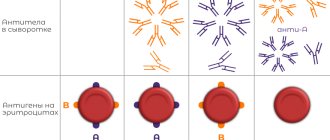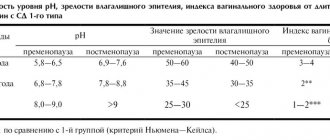Detailed description of the study
The formed elements of human blood - red blood cells - may have some markers on their surface, called antigens.
There are two main such antigens - A and B. Based on their presence, 4 blood groups are distinguished: O(I) - absence of antigens A and B on the surface of the cell A(II) - antigen A is present on the surface of the erythrocyte B(III) - present on the surface of the erythrocyte antigen B AB (IV) - both antigens are found on the surface of the erythrocyte
These antigens have no physiological role, but determine the compatibility of blood during transfusion. When incompatible blood is transfused, an immune reaction of rejection of the foreign protein develops, which leads to the destruction of red blood cells - hemolysis.
Another marker of blood compatibility during transfusion is the Rh factor. This is a protein that is produced in 85% of Caucasians and 99% of people of the Mongoloid race. It is present on the surface of red blood cells, but does not play a significant role in the life of the body.
When blood containing the Rh factor enters the bloodstream of a person who does not have this protein on the surface of red blood cells, the human immune system perceives it as foreign. As a result, hemolysis develops. Therefore, blood transfusion requires taking into account compatibility not only by blood group, but also by the Rh factor.
It is especially important to know your Rh status for women planning a pregnancy. If a woman with no Rh factor becomes pregnant with an Rh positive man, there is a chance that the child will also have an Rh factor.
In such a case, antibodies to the Rh factor may appear in the mother, which will cause hemolysis of the fetus, which is called Rh conflict. The formation of these antibodies can occur when fetal blood enters the mother's bloodstream. Factors that increase the risk of Rh conflict are:
- Complications of a previous pregnancy in the early stages (ectopic pregnancy or its termination);
- Abdominal injury during pregnancy;
- Vaginal bleeding during pregnancy;
- Medical interventions during pregnancy that require the removal of cells or fluid from the amniotic sac, such as amniocentesis and chorionic villus sampling.
With increasing gestational age, the risk of developing Rh conflict increases. Its appearance in the first trimester leads to missed pregnancy and its early loss; in the case of late Rh conflict, premature birth is possible. The newborn has hemolytic jaundice, which is accompanied by damage to internal organs and requires treatment.
It is important that antibodies to the Rh factor take time to form. Often the first pregnancy with Rh conflict proceeds favorably, since the immune system is just beginning to produce antibodies. The risk of complications in the second and subsequent pregnancies is much higher.
Studying your blood group and Rh factor helps you avoid complications associated with blood transfusions. With regard to the Rh factor, its determination is also important for assessing the risk of Rh conflict during pregnancy.
What is Rh factor
By the middle of the 20th century, scientists received confirmation that the compatibility of people according to the immunological characteristics of blood is not limited to the classical division into four blood groups. A protein was discovered that is present in the blood of approximately 85% of people. Accordingly, approximately 15% of people do not have it. When blood is transfused from the first to the second, the recipient’s body begins to produce antibodies to this protein, that is, this substance is an antigen. In medicine, this protein is designated by the Latin letter D. If protein D is in your blood, it means that you have a positive Rh factor (Rh+)
, and you belong to the majority (85%).
If this antigen is not in your blood, your Rh factor is negative (Rh-)
. The Rh factor does not change throughout life.
What else is prescribed with this study?
Antigens of the KELL system
5.4. Ven. blood 3 days
680 som Add to cart
AT to Rh factor (titer)
5.2. Ven. blood 1 day
350 som Add to cart
Clinical blood test with leukocyte count and ESR (with microscopy of a blood smear to detect pathological changes) (venous blood)
3.9.1. Ven. blood 1 day
550 som Add to cart
Determination of immune antibodies using the ABO system
50.3.2193. Ven. blood 10 days
1,100 som Add to cart
Phenotyping of erythrocytes by antigens C, c, E, e, Cw, K, k
5.5. Ven. blood 6 days
1,360 som Add to cart
Why is the Rh factor important in blood transfusions?
When blood is transfused from a person with Rh+ to a person with Rh-, a conflict occurs regarding the Rh factor
. But if, in the case of a conflict regarding the blood group, the destruction of red blood cells (hemolysis) begins immediately, then in the case of a conflict regarding the Rh factor, there is no hemolysis during the first transfusion. The first contact with antigen D only leads to sensitization of the recipient, that is, his body produces specific antibodies, and sensitivity to the antigen increases. But if the antigen enters the blood of a person with a negative Rh factor again, the body begins to react to the penetration of a foreign agent: red blood cells begin to stick together inside the vessels and destroy. A person feels tightness in the chest, difficulty breathing, pain in the lumbar region. Blood pressure decreases and acute renal failure develops. This complex of symptoms is called hemolytic shock.
Currently, hemolytic shock from blood transfusion is practically excluded. In today's medical practice, blood that matches the recipient's blood group and Rh factor is used for transfusion. In order to eliminate errors, before any operation, the analysis to determine the blood group and Rh factor is done again.
Rh factor when planning pregnancy
The Rh factor is also important when planning pregnancy. If a man has a positive Rh factor and a woman has a negative Rh factor, then in most cases their child will have a positive Rh factor. That is, a situation arises when the mother is Rh-, and the fetus is Rh+. In this case, there is a risk of conflict regarding the Rh factor during pregnancy. This situation requires special attention during pregnancy. It will be necessary to take tests to determine the titer and class of anti-Rhesus antibodies in the blood.
Normally, the mother’s blood and the baby’s blood do not mix during pregnancy, since there is a placental barrier. Therefore, antigen D does not enter the mother’s blood, and antibodies to it are not produced. Therefore, the first pregnancy with a conflict regarding the Rh factor, as a rule, proceeds without complications. However, during childbirth, the genital tract is injured, and the baby’s skin may also be damaged, which means there is a high probability of the antigen entering the mother’s blood. Sensitization of the mother's body occurs, and now the next pregnancy may be complicated. The risk of sensitization during childbirth by cesarean section is especially high. If the first pregnancy was artificially terminated (abortion) or ended in miscarriage, then the risk of maternal sensitization also increases.
In some cases - with diabetes mellitus, preeclampsia, influenza or ARVI suffered during pregnancy - the fetal protection is weakened, and the process of antibody production begins during the gestation period.
If antibodies are already present in the mother's blood, during a new pregnancy they can penetrate the placental barrier and have a detrimental effect on the condition of the fetus (hemolytic disease of the fetus). Under the influence of antibodies, the child’s red blood cells begin to destroy, which leads to damage to the liver, kidneys, and brain. The likelihood of miscarriage increases.
Timely treatment for Rh conflict can significantly reduce the risk of developing the most severe complications of hemolytic disease.
The risk of a conflict due to the Rh factor is not a contraindication for pregnancy and cannot be a reason to terminate it.
Determination of the main blood groups (A, B, O) and Rhesus affiliation
A comprehensive study that allows you to assess whether a patient’s blood belongs to one of the groups according to the ABO system and determine the presence/absence of the Rh antigen.
What is this analysis used for?
- To determine whether a person’s blood group belongs to one of the groups according to the ABO system and the Rh system.
When is the test scheduled?
- When transfusing blood components to a recipient;
- when donating blood by a donor;
- in preparation for surgical operations;
- when planning or during pregnancy;
- if fetal erythroblastosis is suspected;
- in preparation for transplantation of bone marrow, kidney, liver and other organs and tissues;
- when persons enter military service, into the ranks of the Ministry of Emergency Situations and other law enforcement agencies.
Research method
Agglutination reaction.
What biomaterial can be used for research?
Venous blood.
How to properly prepare for research?
- Eliminate fatty foods from your diet for 24 hours before the test.
General information about the study
Each person has a unique combination of antigens on the surface of their cells, including red blood cells. To date, more than 250 erythrocyte antigens are known, forming about 30 antigenic systems. Clinically, the most important of them are the ABO system and the Rh system.
The ABO system is the main blood compatibility system. It is represented by agglutinogens A and B, which are glycoproteins located on the surface of red blood cells, and agglutinins alpha and beta, which belong to the class of IgM immunoglobulins and circulate in the blood plasma. Depending on the combination of these agglutinogens and agglutinins, 4 blood groups are distinguished according to the ABO system.
The first (I) blood group (the most common in the European population, 42% of the population) is also called O-group, in which agglutinogens A or B are absent on the surface of red blood cells, agglutinins alpha and beta are detected in the plasma.
The second (II) blood group (37%) is also called A-group; agglutinogen A is present on the surface of red blood cells; agglutinin beta is detected in the plasma.
The third (III) blood group (13% of the population) is also called B-blood group; agglutinogen B is present on the surface of red blood cells; agglutinin alpha is detected in the plasma.
The fourth (IV) blood group (the rarest, only 8% of the population) is also called AB blood group; agglutinogens of both types A and B are present on the surface of red blood cells; agglutinins alpha and beta are absent in the plasma.
The Rh system also consists of several antigens, the main one of which is called antigen D, or Rh factor. In approximately 85% of people, the Rh factor (Rh-positive blood) can be detected on the surface of red blood cells.
The belonging of a person’s blood to a certain group according to the ABO system and the Rh system is genetically determined and does not change throughout life.
What is the research used for?
- To determine whether a person’s blood group belongs to one of the groups according to the ABO system and the Rh system.
What do the results mean?
| Results of blood group determination using the ABO system | |||
| Agglutinogens on the surface of red blood cells | Agglutinins in blood serum | Blood type, designation in Roman numerals | Blood group, designation in Latin letters |
| None | alpha and beta | I | O |
| A | beta | II | A |
| IN | alpha | III | B |
| AB | None | IV | AB |
| Results of determining the Rh factor | |
| Rh factor on the surface of red blood cells | |
| Found | Rh positive blood, Rh+ |
| Not found | Rh negative blood, Rh- |
What can influence the result?
- The presence of specific proteins (M-protein, cold antibodies) or certain bacteria in the patient's serum may interfere with the agglutination reaction used in the test.
- Taking certain medications (levodopa, methyldopa) can lead to false-positive Rh factor test results.







